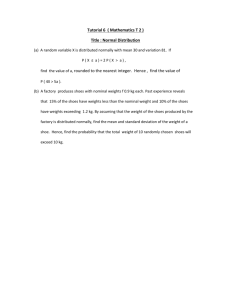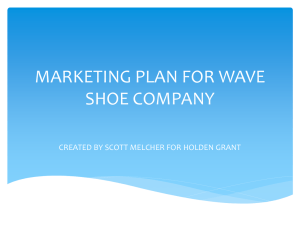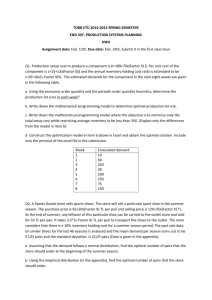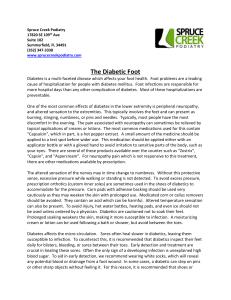How To Prevent and Treat Shin Splints
advertisement
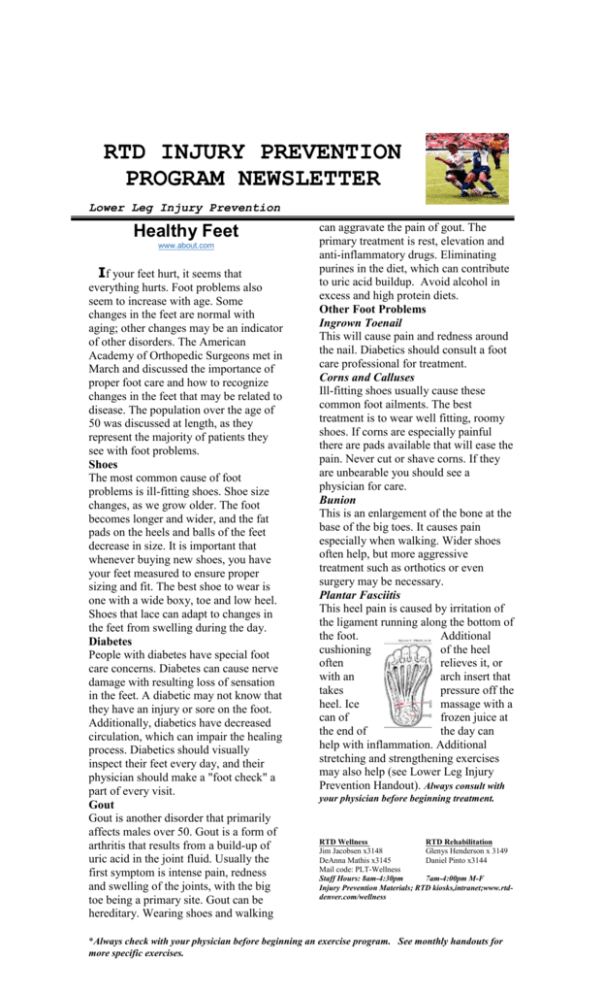
RTD INJURY PREVENTION PROGRAM NEWSLETTER Lower Leg Injury Prevention Healthy Feet www.about.com If your feet hurt, it seems that everything hurts. Foot problems also seem to increase with age. Some changes in the feet are normal with aging; other changes may be an indicator of other disorders. The American Academy of Orthopedic Surgeons met in March and discussed the importance of proper foot care and how to recognize changes in the feet that may be related to disease. The population over the age of 50 was discussed at length, as they represent the majority of patients they see with foot problems. Shoes The most common cause of foot problems is ill-fitting shoes. Shoe size changes, as we grow older. The foot becomes longer and wider, and the fat pads on the heels and balls of the feet decrease in size. It is important that whenever buying new shoes, you have your feet measured to ensure proper sizing and fit. The best shoe to wear is one with a wide boxy, toe and low heel. Shoes that lace can adapt to changes in the feet from swelling during the day. Diabetes People with diabetes have special foot care concerns. Diabetes can cause nerve damage with resulting loss of sensation in the feet. A diabetic may not know that they have an injury or sore on the foot. Additionally, diabetics have decreased circulation, which can impair the healing process. Diabetics should visually inspect their feet every day, and their physician should make a "foot check" a part of every visit. Gout Gout is another disorder that primarily affects males over 50. Gout is a form of arthritis that results from a build-up of uric acid in the joint fluid. Usually the first symptom is intense pain, redness and swelling of the joints, with the big toe being a primary site. Gout can be hereditary. Wearing shoes and walking can aggravate the pain of gout. The primary treatment is rest, elevation and anti-inflammatory drugs. Eliminating purines in the diet, which can contribute to uric acid buildup. Avoid alcohol in excess and high protein diets. Other Foot Problems Ingrown Toenail This will cause pain and redness around the nail. Diabetics should consult a foot care professional for treatment. Corns and Calluses Ill-fitting shoes usually cause these common foot ailments. The best treatment is to wear well fitting, roomy shoes. If corns are especially painful there are pads available that will ease the pain. Never cut or shave corns. If they are unbearable you should see a physician for care. Bunion This is an enlargement of the bone at the base of the big toes. It causes pain especially when walking. Wider shoes often help, but more aggressive treatment such as orthotics or even surgery may be necessary. Plantar Fasciitis This heel pain is caused by irritation of the ligament running along the bottom of the foot. Additional cushioning of the heel often relieves it, or with an arch insert that takes pressure off the heel. Ice massage with a can of frozen juice at the end of the day can help with inflammation. Additional stretching and strengthening exercises may also help (see Lower Leg Injury Prevention Handout). Always consult with your physician before beginning treatment. RTD Wellness RTD Rehabilitation Jim Jacobsen x3148 Glenys Henderson x 3149 DeAnna Mathis x3145 Daniel Pinto x3144 Mail code: PLT-Wellness Staff Hours: 8am-4:30pm 7am-4:00pm M-F Injury Prevention Materials; RTD kiosks,intranet;www.rtddenver.com/wellness *Always check with your physician before beginning an exercise program. See monthly handouts for more specific exercises. How To Prevent and Treat Shin Splints Wendy Bumgardner www.about.com Always remember the 10% rule; never increase activity by more than 10% at one time. Walk or run on softer surfaces such as dirt, grass, or cinder rather than concrete. Replace your shoes and insoles regularly. Stretch and strengthen muscles in lower leg and foot daily. Gradually, add non-impact exercise back into your routine. Warm up at an easy pace for 5-10 min. before exercise. Do not exercise with pain. Ice, compression and anti-inflammatory medicine may help after workouts. Consult with your physician before treatment. How to Buy Athletic Shoes Lloyd Nesbitt, DPM THE PHYSICIAN AND SPORTSMEDICINE VOL 27 - NO. 12 - NOVEMBER 1999 Although the right pair of athletic shoes may not enhance sports performance, it might help you avoid discomfort or even injury. Here are tips about what to look for in your next pair. How do I know when it's time to replace my old shoes? Place your old shoes on a table or other flat surface and look at them from the back. If they lean inward or outward or show signs of excessive wear like badly worn edges of the sole, it's probably time for a new pair. Even if they look like they're in good shape, if you've logged 500 or more miles in them, or if you start to notice pain in your feet, ankles, legs, or knees though you haven't changed your exercise routine, worn-out shoes may be a factor. There are so many styles and brands-where do I start? If your old shoes lean inward or if your feet are flat or tend to roll inward when you walk or run, you should look for shoes with added support under the arch. If your shoes lean outward or your arches are high, you need plenty of cushioning. The shoe's material should be flexible and allow your foot to "breathe," as shoes that have mesh fabric do. Most people like the feel of a softer shoe, but with the pressure on shoes during exercise, a softer shoe may not last as long as a firmer one. Think about protection from injuries. Shoes don't have to be very heavy to offer good support. Also, thin or flimsy shoes like canvas sneakers can worsen some problems such as calf or Achilles tendon pain. A shoe whose heel compresses too easily can overstretch your calf. In addition, soles that bend at the ball of the foot, not under the arch, offer better support. Styles change about every 19 months, and you may not like the new version of your favorite model of shoe. If this happens, a knowledgeable salesperson should be able to help you find a style of athletic shoe comparable to your old favorite. How can I get the best fit? No matter where you go to buy your shoes, try to find a knowledgeable salesperson that understands footwear and will take the time to guide you to the best style and size for you. Try to shop at the end of the day or after a workout when your feet are generally at their largest. Wear the type of socks you usually wear during exercise, and if you use orthotic devices (orthoses) for your feet, make sure you wear them when you're trying on shoes. Choose shoes for their fit, not by the size you've worn in the past. It's important to have both the length and width of your feet measured every time you shop for shoes, since foot size often changes with age. There should be a thumbnail's width (about 1/2 inch) between the longest toe and the end of the shoe on your longer foot. Be sure to have the salesperson check the fit of both shoes for you when you are standing up. If you bend over to check it yourself, you will change the position of your foot in the shoe. The widest part of your foot should be in the widest part of the shoe. The sides of your foot should not extend over the sole of the shoe, and your foot shouldn't move from side to side inside the shoe. After you've found a pair that you think fits well, walk or run a little in the store-some stores even have a treadmill for that purpose. The shoes should feel comfortably snug--not tight or too loose-and you should not feel the stitching or seams on the inside of the shoes. Regardless of the style, fit is the most important consideration. No matter how good you hear a shoe is, if it doesn't fit you or you're not comfortable with it, don't buy it. No one brand will fit everyone's needs. *Always check with your physician before beginning an exercise program. See monthly handouts for more specific exercises. *Always check with your physician before beginning an exercise program. See monthly handouts for more specific exercises.
